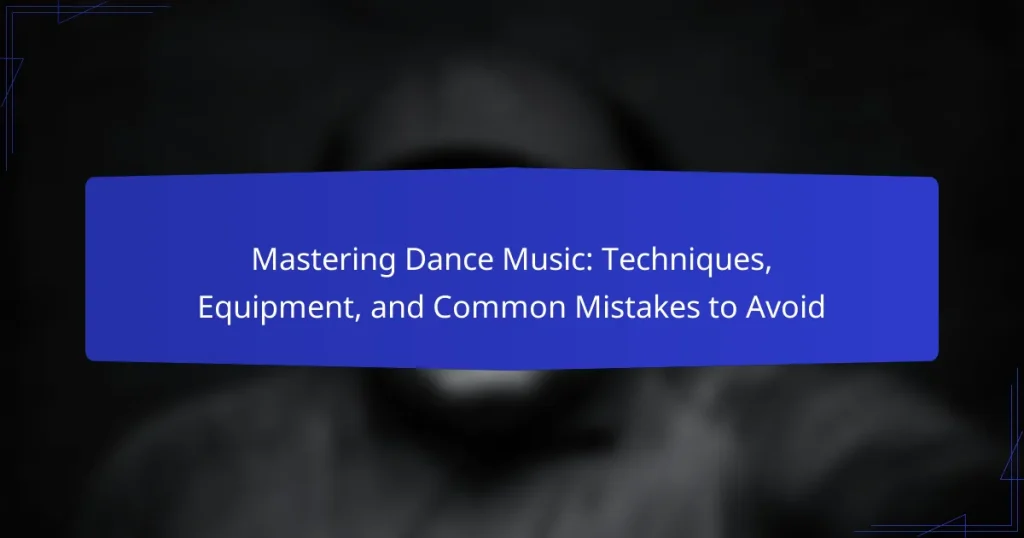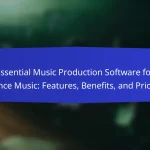Mastering dance music is a crucial stage in the music production process that involves preparing and transferring recorded audio to ensure a polished and consistent final track. This process enhances sound quality through techniques such as equalization, compression, and limiting, while also addressing dynamic range and stereo imaging. Common mistakes in mastering include excessive compression, overloading effects, and neglecting to reference tracks, all of which can compromise the final product. To achieve optimal results, it is essential to focus on critical listening, use high-quality monitoring equipment, adhere to industry standards for loudness, and seek professional feedback. This article will provide an overview of effective mastering techniques, essential equipment, and key pitfalls to avoid in the dance music genre.

What is Mastering Dance Music?
Mastering dance music is the final step in the music production process. It involves preparing and transferring recorded audio from a source to a data storage device. The goal is to ensure the track sounds polished and consistent across various playback systems. Mastering enhances the overall sound quality and balances the tonal elements of the music. This process typically includes equalization, compression, and limiting. Mastering also addresses issues like dynamic range and stereo imaging. Professional mastering can significantly impact a track’s commercial viability. It is essential for achieving a competitive sound in the dance music genre.
How does the mastering process enhance dance music tracks?
The mastering process enhances dance music tracks by optimizing sound quality and ensuring consistency. It involves adjusting levels, equalization, and compression. These adjustments improve clarity and impact. Mastering also prepares tracks for various playback systems. This ensures they sound good on speakers, headphones, or club systems. A well-mastered track can increase listener engagement. According to a study by the Audio Engineering Society, proper mastering can elevate perceived loudness by up to 3 dB. This makes the track more competitive in a crowded music landscape.
What are the key stages involved in mastering dance music?
The key stages involved in mastering dance music include preparation, equalization, compression, limiting, and finalizing. Preparation involves organizing the mix and ensuring all elements are balanced. Equalization adjusts frequencies to enhance clarity and remove unwanted sounds. Compression controls dynamic range, making quiet sounds louder and loud sounds quieter. Limiting prevents clipping and ensures the track reaches competitive loudness levels. Finalizing includes checking the track on various playback systems and formats. Each stage contributes to achieving a polished and professional sound.
How do different mastering techniques affect the final sound?
Different mastering techniques significantly affect the final sound of a music track. Equalization shapes the frequency balance, enhancing clarity or warmth. Compression controls dynamic range, making the sound more consistent and punchy. Limiting increases overall loudness without distortion, allowing tracks to compete in volume. Stereo widening enhances spatial characteristics, creating a fuller soundstage. Each technique contributes uniquely, influencing how listeners perceive the track. For instance, excessive compression may lead to a lifeless sound, while proper use can enhance energy and presence. The choice of techniques ultimately defines the sonic identity of the music.
What are the essential techniques for mastering dance music?
The essential techniques for mastering dance music include equalization, compression, limiting, and stereo imaging. Equalization shapes the frequency balance of the track. This technique enhances clarity and removes unwanted frequencies. Compression controls the dynamic range. It ensures consistent volume levels throughout the track. Limiting prevents clipping and distortion by capping the maximum output level. Stereo imaging widens the sound stage, creating a more immersive listening experience. These techniques are critical for achieving professional sound quality in dance music. Mastering engineers often use these methods to ensure tracks translate well across different playback systems.
What role does equalization play in mastering dance music?
Equalization is crucial in mastering dance music as it shapes the overall tonal balance. It allows engineers to enhance or reduce specific frequency ranges. This process ensures that all elements of the mix are clear and well-defined. Proper equalization can prevent frequency masking, which occurs when sounds overlap and reduce clarity. For example, boosting the low frequencies can add warmth and impact to bass elements. Conversely, cutting unwanted frequencies can create space for vocals and leads. Mastering engineers often use equalization to achieve a polished, professional sound. This technique is essential for ensuring the track translates well across various playback systems.
How does compression improve the dynamics of dance tracks?
Compression improves the dynamics of dance tracks by controlling the dynamic range. It reduces the volume of the loudest parts while boosting the quieter sections. This creates a more balanced sound. A consistent level helps maintain listener engagement. Compression also adds punch to the kick and snare, essential for dance music. It can enhance the overall energy of the track. According to a study by the Audio Engineering Society, well-applied compression can increase perceived loudness without distortion. This technique is crucial in mastering dance tracks for club environments.
What is the importance of stereo imaging in mastering?
Stereo imaging in mastering is crucial for creating a balanced and immersive listening experience. It enhances the spatial perception of sound within a mix. Proper stereo imaging allows individual elements to be placed distinctly in the stereo field. This clarity helps listeners identify instruments and vocals more easily. Additionally, it contributes to the overall depth and richness of the audio. Studies show that well-defined stereo imaging can increase listener engagement and satisfaction. Effective stereo imaging can also prevent frequency masking between elements. Therefore, mastering with attention to stereo imaging is essential for achieving a professional sound.
What equipment is necessary for mastering dance music?
Essential equipment for mastering dance music includes a digital audio workstation (DAW), studio monitors, and audio interfaces. A DAW allows for editing and mixing audio tracks effectively. Studio monitors provide accurate sound reproduction for critical listening. Audio interfaces improve sound quality and connectivity between instruments and the computer. Additionally, high-quality headphones are important for detailed listening. Mastering plugins, such as equalizers and compressors, enhance the final sound. Metering tools are also crucial for analyzing levels and dynamics. This combination of equipment ensures professional-quality mastering in dance music.
What types of software are commonly used in the mastering process?
Commonly used software in the mastering process includes digital audio workstations (DAWs), plugins, and specialized mastering software. Popular DAWs for mastering are Pro Tools, Logic Pro, and Ableton Live. These platforms provide essential tools for editing and mixing audio. Mastering plugins like iZotope Ozone, Waves, and FabFilter offer advanced processing capabilities. These plugins help in equalization, compression, and limiting. Dedicated mastering software such as LANDR and Mastering The Mix also streamline the mastering workflow. These tools are designed specifically for finalizing tracks for distribution.
How do different types of hardware impact the mastering quality?
Different types of hardware significantly impact mastering quality. High-quality converters enhance audio fidelity during the mastering process. Analog equipment can add warmth and character to the sound, improving its overall appeal. Digital processors offer precision and flexibility, allowing for detailed adjustments. The choice of monitors affects how accurately the final mix translates across various playback systems. For instance, studio monitors with flat frequency response provide a more accurate representation of the audio. Additionally, the use of outboard gear for compression and equalization can shape the final sound, contributing to a polished result. Ultimately, the combination of hardware types determines the clarity, depth, and emotional impact of the mastered track.

What common mistakes should be avoided in mastering dance music?
Common mistakes to avoid in mastering dance music include excessive compression, which can lead to a loss of dynamics. Overloading the mix with too many effects can muddy the sound. Neglecting to reference tracks can result in an unbalanced final product. Failing to check the mix on various playback systems may lead to poor translation. Ignoring the importance of proper gain staging can cause distortion. Lastly, not taking breaks during the mastering process can lead to ear fatigue and poor decision-making.
Why is it crucial to avoid over-compression in mastering?
Over-compression in mastering is crucial to avoid because it can lead to a loss of dynamic range. Dynamic range is essential for maintaining the emotional impact of a track. When over-compression occurs, the music can sound flat and lifeless. This diminishes the listener’s experience and engagement. Additionally, over-compression can introduce unwanted artifacts. These artifacts may distort the sound quality. A balanced approach to compression preserves the clarity and punch of the mix. Studies show that music with a wider dynamic range is often preferred by listeners. Therefore, avoiding over-compression is vital for achieving a professional sound.
What are the signs of over-compression in a dance track?
Signs of over-compression in a dance track include a lack of dynamic range. The track may sound flat or lifeless. Transients can be overly softened or completely squashed. Loudness can be excessive, leading to distortion. The mix may lose clarity, making individual elements indistinguishable. There can be an unnatural pumping effect, disrupting the rhythm. Additionally, over-compressed tracks often fail to engage listeners emotionally. These signs indicate that the compression settings may need adjustment to restore balance and dynamics.
How can over-compression affect the listener’s experience?
Over-compression negatively impacts the listener’s experience by reducing dynamic range. This makes music sound flat and lifeless. When dynamics are compressed excessively, subtle nuances are lost. Listeners may find the sound tiring or fatiguing over time. Over-compression can also lead to distortion, making the audio unpleasant. Many listeners prefer a balanced mix with clear dynamics. Research shows that well-balanced dynamics enhance listener engagement. Thus, over-compression can diminish overall enjoyment and appreciation of the music.
How can poor equalization ruin a dance music track?
Poor equalization can ruin a dance music track by causing frequency imbalances. These imbalances can lead to muddiness in the mix. Muddiness occurs when low frequencies overpower other elements. This makes it difficult for listeners to distinguish individual sounds. Additionally, harsh frequencies can create discomfort for the ears. This discomfort may lead to listener fatigue. A well-balanced equalization enhances clarity and impact in dance music. Studies show that tracks with poor equalization often fail to engage audiences effectively.
What are the common pitfalls of equalization in mastering?
Common pitfalls of equalization in mastering include over-processing, which can lead to a loss of dynamics. Excessive boosting of frequencies may cause distortion and muddiness in the mix. Neglecting the context of the entire track can result in an unbalanced sound. Failing to use high-quality monitoring equipment can mislead decisions about frequency adjustments. Relying solely on visual analysis without trusting one’s ears can lead to poor choices. Not considering the playback environment may also affect the final result. Lastly, ignoring the genre-specific characteristics can result in a sound that doesn’t resonate with the intended audience.
How can you achieve a balanced EQ in your dance music?
To achieve a balanced EQ in your dance music, use precise frequency adjustments. Start by identifying the key elements in your mix. Focus on the bass, kick, and vocals as primary components. Use a spectrum analyzer to visualize frequency distribution. Cut unnecessary low frequencies from non-bass elements to prevent muddiness. Boost essential frequencies to enhance clarity. For instance, a slight boost around 2-4 kHz can add presence to vocals. Always reference your mix against professional tracks for comparison. Regularly check your EQ settings on different playback systems to ensure balance. This method helps maintain a clear and dynamic sound throughout the track.
What are the effects of neglecting reference tracks in mastering?
Neglecting reference tracks in mastering can lead to a lack of sonic clarity and balance. This oversight often results in a final mix that does not translate well across different playback systems. Without reference tracks, mastering engineers may struggle to achieve industry-standard loudness levels. The absence of a benchmark can cause inconsistencies in tonal balance, leading to a mix that sounds either too harsh or too dull. Additionally, neglecting references can hinder the ability to identify frequency masking issues. This can result in a less engaging listening experience. Studies show that using reference tracks can improve the overall quality of the master by providing a clear target. Therefore, omitting them can significantly diminish the effectiveness of the mastering process.
How can reference tracks guide the mastering process?
Reference tracks can guide the mastering process by providing a sonic benchmark for comparison. They help engineers identify tonal balance, loudness levels, and frequency distribution. By analyzing reference tracks, mastering engineers can assess the clarity and dynamics of their own mixes. This process allows for adjustments to be made, ensuring that the final product meets industry standards. Reference tracks also assist in maintaining consistency across different listening environments. They serve as a tool for evaluating how well a track translates to various playback systems. Using reference tracks can ultimately enhance the overall quality of the mastered audio.
What should you listen for when using reference tracks?
When using reference tracks, listen for the overall tonal balance. This includes the frequency distribution across lows, mids, and highs. Assess how the kick and bass interact to create a solid foundation. Pay attention to the clarity of the vocals and lead instruments. Notice the stereo imaging and how elements are panned. Evaluate the dynamic range and how loudness is managed. Finally, observe the overall energy and emotional impact of the track. These aspects help in achieving a professional sound in your own mix.

How can you ensure a successful mastering process?
To ensure a successful mastering process, focus on critical listening and technical precision. Use high-quality monitors and headphones to accurately assess sound. Maintain a consistent monitoring environment to avoid misleading acoustics. Employ professional mastering software and tools for optimal results. Pay attention to dynamic range and loudness levels, adhering to industry standards. Reference similar tracks to gauge quality and make necessary adjustments. Finally, seek feedback from experienced professionals to refine your work. These steps contribute to achieving a polished final product that meets industry expectations.
What best practices should be followed during mastering?
Best practices during mastering include maintaining consistent volume levels. This ensures a balanced sound across different playback systems. Use reference tracks to compare your mix against professional standards. This helps identify areas for improvement. Employ high-quality monitoring equipment for accurate sound reproduction. This is crucial for making informed decisions. Utilize EQ to enhance clarity and remove unwanted frequencies. This can improve the overall sonic quality. Apply compression carefully to control dynamics without losing energy. This maintains the track’s impact. Finally, leave headroom for the final mix. This prevents distortion during playback on various platforms.
How important is it to take breaks during the mastering process?
Taking breaks during the mastering process is crucial for maintaining audio quality. Extended periods of focused listening can lead to ear fatigue. This fatigue can impair a person’s ability to make accurate decisions about sound quality. Research shows that taking breaks helps refresh auditory perception. It allows for a more objective evaluation of the music. Experts recommend breaks every 30 to 60 minutes. This practice can enhance overall mastering effectiveness.
What role does feedback play in achieving a polished master?
Feedback is essential in achieving a polished master. It provides critical insights into the strengths and weaknesses of a track. By receiving feedback from peers, mentors, or listeners, artists can identify areas that require improvement. This process helps refine elements like mixing, dynamics, and overall sound quality. Furthermore, feedback fosters collaboration and encourages new ideas. It can lead to adjustments that enhance the emotional impact of the music. Ultimately, incorporating feedback is a vital step in the mastering process, ensuring the final product meets professional standards.
What tools can help streamline the mastering process?
Digital audio workstations (DAWs) are essential tools that can help streamline the mastering process. Popular DAWs like Ableton Live, Logic Pro, and Pro Tools offer integrated mastering features. These features include equalization, compression, and limiting tools that enhance audio quality. Additionally, dedicated mastering software like iZotope Ozone provides advanced algorithms for precise audio adjustments.
Plugins such as FabFilter Pro-L and Waves L2 can optimize loudness while preserving dynamics. Metering tools like Youlean Loudness Meter help ensure compliance with loudness standards. Using these tools collectively can significantly reduce time spent on mastering while improving the final output quality.
How can mastering plugins enhance your workflow?
Mastering plugins can significantly enhance your workflow by streamlining audio processing tasks. They automate repetitive actions, allowing for faster project completion. Mastering plugins often include presets that can be applied quickly to achieve professional sound. This reduces the time spent on manual adjustments. Additionally, they provide real-time feedback, enabling instant evaluation of changes. With features like batch processing, multiple tracks can be mastered simultaneously, saving time. Mastering plugins also improve consistency across tracks, ensuring a cohesive final product. Their intuitive interfaces often require less training, allowing for immediate integration into existing workflows.
What are some recommended mastering software options?
Some recommended mastering software options include iZotope Ozone, Waves L2 Ultramaximizer, and FabFilter Pro-L 2. iZotope Ozone is known for its comprehensive suite of mastering tools, including EQ, dynamics, and limiting. Waves L2 Ultramaximizer is praised for its simplicity and effectiveness in maximizing loudness. FabFilter Pro-L 2 offers advanced features like true peak limiting and detailed metering. Each of these options is widely used by professionals in the music industry for mastering tracks.
What final tips can help you master dance music effectively?
To master dance music effectively, focus on sound quality, dynamics, and EQ balance. Use high-quality reference tracks to guide your mastering process. Pay attention to loudness levels, aiming for industry standards like -14 LUFS for streaming. Utilize compression wisely to enhance dynamics without losing clarity. Implement stereo widening techniques to create a fuller sound. Regularly check your mixes on various playback systems to ensure consistency. Lastly, take breaks during the mastering session to maintain objective listening. These practices are supported by industry professionals and mastering engineers who emphasize the importance of these techniques for achieving professional results.
How can you develop your unique mastering style?
To develop your unique mastering style, focus on understanding your artistic vision. Experiment with different techniques and tools to find what resonates with you. Analyze tracks you admire to identify their characteristics. Incorporate your personal influences and preferences into your mastering process. Consistent practice will refine your skills over time. Seek feedback from peers to gain new perspectives. Stay updated with industry trends to inspire innovation. Document your processes to track your evolution and identify what works best for you.
What resources are available for further learning in mastering dance music?
Online courses are available for further learning in mastering dance music. Platforms like Coursera and Udemy offer specialized courses. These courses cover topics like mixing and mastering techniques. Books on audio mastering provide in-depth knowledge. Notable titles include “Mastering Audio: The Art and the Science” by Bob Katz. YouTube channels dedicated to music production offer tutorials and tips. Forums such as Gearslutz facilitate discussions among audio professionals. Additionally, software manuals for DAWs like Ableton Live and FL Studio contain valuable insights. These resources are widely recognized and utilized by aspiring and professional audio engineers.
Mastering dance music is the final step in the music production process, aimed at preparing and enhancing audio for optimal playback across various systems. This article covers essential techniques such as equalization, compression, and limiting, which improve sound quality and dynamic range. It also discusses the importance of stereo imaging and the necessary equipment and software for effective mastering. Common mistakes to avoid, including over-compression and poor equalization, are highlighted to ensure a polished and professional sound. Additionally, best practices and resources for further learning are provided to aid in developing a unique mastering style.


